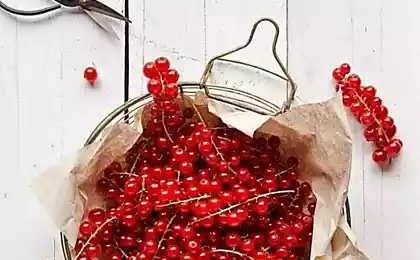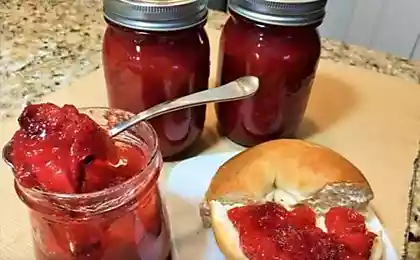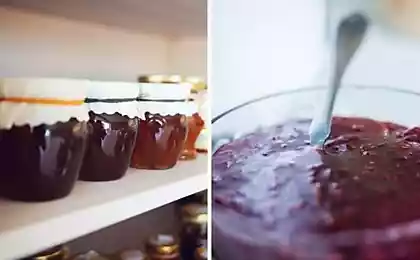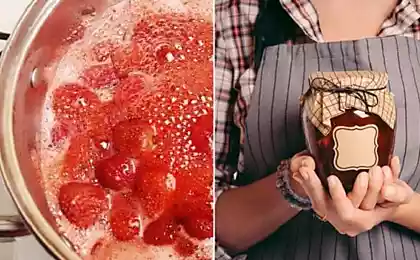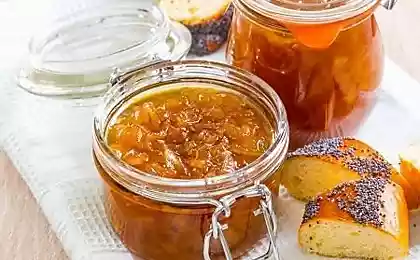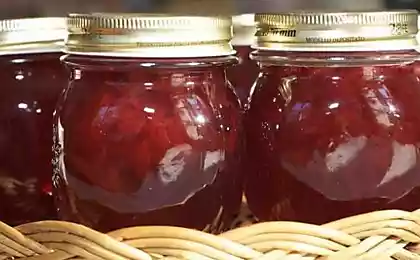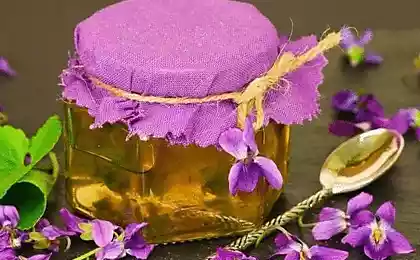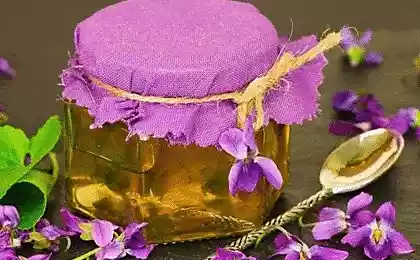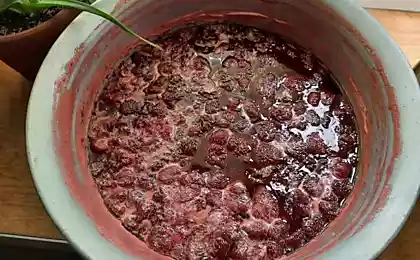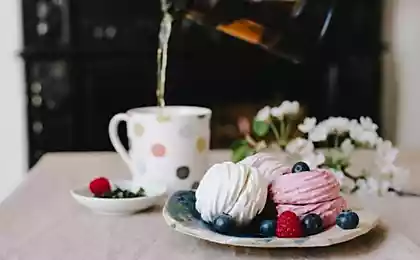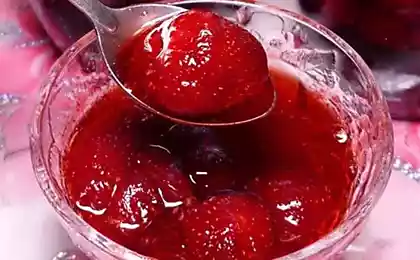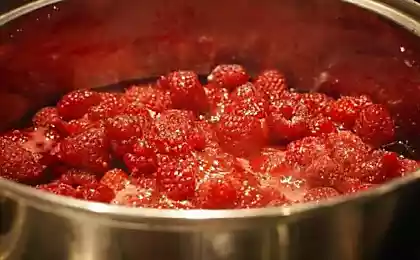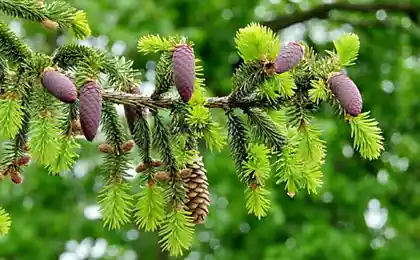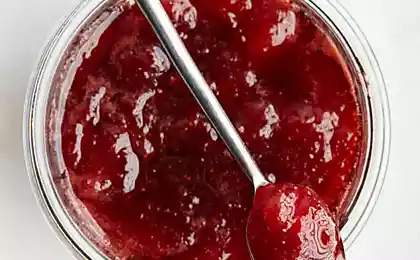462
10 rules of magic jam
It looks like witchcraft: you take the weight of fresh fruit or berries, wave a magic wand (or a silicone spatula or wooden spoon) over a strongly boiling, gurgling, and perfectly smelling of pot, and the sweet mass is converted into a transparent Golden-amber jam. But the magic has laws and rules. Here are 10 secret of the recommendations. Only here and just for you!
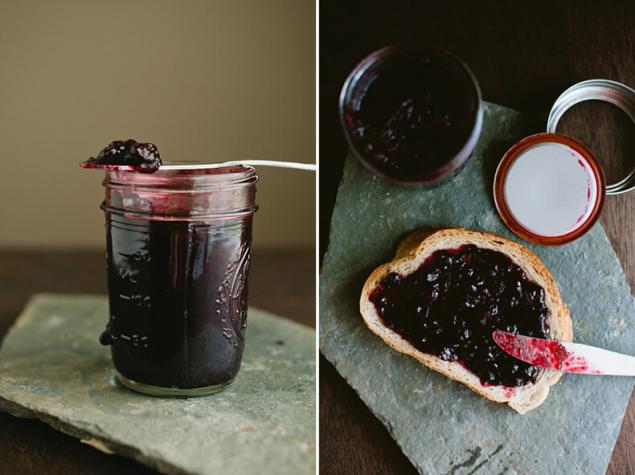
1. Best sweet blanks are made from the freshly collected berries and fruits.
Ideally, they should be ripped a maximum of 2 hours ago. If not your garden, buy the freshest fruits, do not chase a crumpled and "discounted". Fresh berries and fruits you can add just a little overripe fruits, as they contain more pectin. Thanks to his participation, you will get a good jelly-like structure of the liquid part of the billet and more complex the taste of the product. Pectin is particularly important when cooking jam or jam.
2. When gathering fruit, growing on trees (apples, pears, plums, apricots, dog), don't lie and don't Strachowice them on the ground.
Places bruises on the fruit quickly they darken and begin to deteriorate. Fruit take hands, each fruit separately and carefully put into the basket or sieve. Wash and completely dry the fruit and only then begin cooking.
3. Jam essentially is berries, fruit and sugar.
You can play with this ratio as much as you want, but remember too much fruit will give you the loss of a unique jam consistency of the fruit; the excess sugar will start to crystallize during storage. Be sure to weigh processed and prepared for cooking fruit.
Calculating the ratio of sugar and berries, keep in mind, please, that berry berry — strife! Ripe strawberries with low acidity and low content of pectin requires more sugar, about 70% of the total weight. And blueberries will be quite and 40%. For apricots and plums – 45%, cherries and peaches – 60%. .

4. Experiment not only with sugar but with natural flavors.
Honey and maple syrup, although in ordinary life and can replace sugar in jam to behave differently. So use them metered, only as flavourings. For example, jam of apricots and plums. Also work gently with freshly ground pink pepper (for pears), nutmeg (mix of strawberries, raspberries and blackberries), rosemary and thyme (plum and BlackBerry). If you add in jam cinnamon sticks (figs, raisins), anise (for apricots) and cardamom (for oranges with dates), don't forget to remove them before serving.
5. When heated, sugar-berry mass begins to foam and leave the residue on the sides of the pan.
Ensure that the sugar is boiled on a slow fire. Avoid too much mixing of sweet mass, because you can disrupt the integrity of the berries/fruits and cause sugar crystallization. Sweet on the surface of the workpiece formed a lot of foam – this is normal, excess can be neatly set aside in a separate bowl, because foam itself is extremely tasty. Can minimize its quantity, adding a little butter (about 20 g).
6. To make sure that the jam is ready, scoop it with a teaspoon (pre-chilled in the freezer) and remove it for 5 minutes back in the freezer.
When you take a spoon and tilt it is ready the jam should keep good form and syrup should flow like water.
7. Pouring jam jars, do not fill it too much.
Let it be poured at 1-1,5 cm below the upper edge of the neck.

8. A close the neck of the jars of jam in waxed paper and then cover.
That's right! Paper increases the tightness of the workpiece and prevents condensate in the Bank. It is the formation of mold.
9. Optimum storage temperature of the finished jam is 10-12 °C.
Storage time – up to 3 years, but it is rather from the realm of fantasy. How can a tasty and properly cooked jam be stored for so long?
13 recipes for those who don't know what to do with cucumbers
Purify the body: 10 recipes
23 harmonious combination of fruit, vegetables and berries for making jam, marmalade and jam
Apricots and gooseberries \ Apricots and carrots \ Quince with raisins
Japanese quince and courgettes \ with plums Cranberries \ Cranberries with carrots
Cranberries with beets \, Grapes and quince \ cherry and chokeberry
Pear and plum \ Pear and cranberry / Strawberry and red currant
Strawberries and gooseberry / Gooseberries and raspberries \ sea-Buckthorn berries and walnuts
Plum and pear \ Plum and tomato \ red Currants with watermelon
Sweet cherry white and lemon / Blueberries and apples\ chokeberry and black currant
Apples and viburnum\ Apples and pumpkin.
P. S. And remember, only by changing their consumption — together we change the world! ©
Source: www.gastronom.ru/text/10-pravil-pravilnogo-varenja-1008106#

1. Best sweet blanks are made from the freshly collected berries and fruits.
Ideally, they should be ripped a maximum of 2 hours ago. If not your garden, buy the freshest fruits, do not chase a crumpled and "discounted". Fresh berries and fruits you can add just a little overripe fruits, as they contain more pectin. Thanks to his participation, you will get a good jelly-like structure of the liquid part of the billet and more complex the taste of the product. Pectin is particularly important when cooking jam or jam.
2. When gathering fruit, growing on trees (apples, pears, plums, apricots, dog), don't lie and don't Strachowice them on the ground.
Places bruises on the fruit quickly they darken and begin to deteriorate. Fruit take hands, each fruit separately and carefully put into the basket or sieve. Wash and completely dry the fruit and only then begin cooking.
3. Jam essentially is berries, fruit and sugar.
You can play with this ratio as much as you want, but remember too much fruit will give you the loss of a unique jam consistency of the fruit; the excess sugar will start to crystallize during storage. Be sure to weigh processed and prepared for cooking fruit.
Calculating the ratio of sugar and berries, keep in mind, please, that berry berry — strife! Ripe strawberries with low acidity and low content of pectin requires more sugar, about 70% of the total weight. And blueberries will be quite and 40%. For apricots and plums – 45%, cherries and peaches – 60%. .

4. Experiment not only with sugar but with natural flavors.
Honey and maple syrup, although in ordinary life and can replace sugar in jam to behave differently. So use them metered, only as flavourings. For example, jam of apricots and plums. Also work gently with freshly ground pink pepper (for pears), nutmeg (mix of strawberries, raspberries and blackberries), rosemary and thyme (plum and BlackBerry). If you add in jam cinnamon sticks (figs, raisins), anise (for apricots) and cardamom (for oranges with dates), don't forget to remove them before serving.
5. When heated, sugar-berry mass begins to foam and leave the residue on the sides of the pan.
Ensure that the sugar is boiled on a slow fire. Avoid too much mixing of sweet mass, because you can disrupt the integrity of the berries/fruits and cause sugar crystallization. Sweet on the surface of the workpiece formed a lot of foam – this is normal, excess can be neatly set aside in a separate bowl, because foam itself is extremely tasty. Can minimize its quantity, adding a little butter (about 20 g).
6. To make sure that the jam is ready, scoop it with a teaspoon (pre-chilled in the freezer) and remove it for 5 minutes back in the freezer.
When you take a spoon and tilt it is ready the jam should keep good form and syrup should flow like water.
7. Pouring jam jars, do not fill it too much.
Let it be poured at 1-1,5 cm below the upper edge of the neck.

8. A close the neck of the jars of jam in waxed paper and then cover.
That's right! Paper increases the tightness of the workpiece and prevents condensate in the Bank. It is the formation of mold.
9. Optimum storage temperature of the finished jam is 10-12 °C.
Storage time – up to 3 years, but it is rather from the realm of fantasy. How can a tasty and properly cooked jam be stored for so long?
13 recipes for those who don't know what to do with cucumbers
Purify the body: 10 recipes
23 harmonious combination of fruit, vegetables and berries for making jam, marmalade and jam
Apricots and gooseberries \ Apricots and carrots \ Quince with raisins
Japanese quince and courgettes \ with plums Cranberries \ Cranberries with carrots
Cranberries with beets \, Grapes and quince \ cherry and chokeberry
Pear and plum \ Pear and cranberry / Strawberry and red currant
Strawberries and gooseberry / Gooseberries and raspberries \ sea-Buckthorn berries and walnuts
Plum and pear \ Plum and tomato \ red Currants with watermelon
Sweet cherry white and lemon / Blueberries and apples\ chokeberry and black currant
Apples and viburnum\ Apples and pumpkin.
P. S. And remember, only by changing their consumption — together we change the world! ©
Source: www.gastronom.ru/text/10-pravil-pravilnogo-varenja-1008106#


